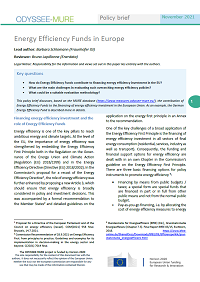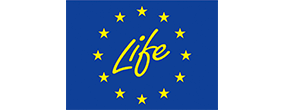Summary
Key questions
- How do Energy Efficiency Funds contribute to financing energy efficiency investment in the EU?
- What are the main challenges in evaluating such overarching energy efficiency policies?
- What could be a suitable evaluation methodology?
This policy brief discusses, based on the MURE database, the contribution of Energy Efficiency Funds to the financing of energy efficiency investment in the European Union. As an example, the German Energy Efficiency Fund is described more in details.
Lead authors: Barbara Schlomann (Fraunhofer ISI)
Reviewers: Bruno Lapillonne (Enerdata)
Financing energy efficiency investment and the role of Energy Efficiency Funds
Energy efficiency is one of the key pillars to reach ambitious energy and climate targets. At the level of the EU, the importance of energy efficiency was strengthened by embedding the Energy Efficiency First Principle both in the Regulation on the Gover-nance of the Energy Union and Climate Action (Regulation (EU) 2018/1999) and in the Energy Efficiency Directive (Directive (EU) 2018/2002). In the Commission's proposal for a recast of the Energy Efficiency Directive1, the role of energy efficiency was further enhanced by proposing a new Article 3, which should ensure that energy efficiency is broadly considered in policy and investment decisions. This was accompanied by a formal recommendation to the Member States2 and detailed guidelines on the application on the energy first principle in an Annex to the recommendation.
One of the key challenges of a broad application of the Energy Efficiency First Principle is the financing of energy efficiency investment in all sectors of final energy consumption (residential, services, industry as well as transport). Consequently, the funding and financial support options for energy efficiency are dealt with in an own Chapter in the Commission's guideline on the Energy Efficiency First Principle. There are three basic financing options for policy instruments to promote energy efficiency3:
- Financing by means from public budgets / taxes; a special form are special funds that are financed in part or in full from other public means and not from the normal public budget.
- Pay-as-you-go financing, i.e. by allocating the cost of energy efficiency measures to energy prices (as e.g. in several energy efficiency obligation schemes).
- Use of investor capital, which is usually related to a specific measure (e.g. energy performance contracts, "Pay-as-you-save" approaches or new crowdfunding schemes).
Bertoldi et al. (2020)4 classify current financial instruments supporting energy efficiency measures in the EU building sector according to:
- traditional and well-established instruments, such as grants and subsidies, tax incentives and soft loans;
- tested and growing instruments, such as energy efficiency obligation schemes, energy performance contracting or energy service agreements;
- new and innovative instruments such as energy efficiency feed-in tariffs, crowdfunding or on-bill finance.
Energy Efficiency Funds belong to the group of traditional and well-established financial instruments. They have a long history in Europe and the United States which goes back to the 1990s. The UK Energy Saving Trust5 was already founded in 1992. The Danish Electricity Fund (elseparefonden) and similar funds in in some states of the U.S. (California, Oregon, Connecticut, Massachusetts) followed in the mid-1990s.
Compared to single financial measures, which usually focus on individual energy efficiency actions in a specific sector, funds have some characteristics by which they stand out from single traditional instruments for financing energy efficiency measures:
- Energy Efficiency Funds are broader and typically comprise several types of energy efficiency instruments (financial support programmes as well as informational measures) and different sectors (building, but often also industry and services, sometimes transport). With such an overarching approach, synergies between different measures should be better exploited.
- Some Funds also have an organisational structure, whereas others only deliver financial means for the implementation of energy efficiency programmes.
- In order to ensure long-term financing of energy efficiency measures, the financial means of these funds usually do not only come from the fluctuating general public budget, but also from other sources (as e.g. revenues from the EU-ETS or charges on electricity or gas tariffs).
The methodological challenge for the evaluation of such overarching financial instruments as energy efficiency funds is that both the impact of the individual actions and their interaction within the fund must be considered. This will be further elaborated later in this policy brief.
In the MURE database6, Energy Efficiency Funds are usually included in the general cross-cutting section, whereas the (most important) individual measures within a fund are included in the respective sectors (residential, services, industry, transport). The MURE database includes almost 370 financial measures at the sectoral level (single measures and measures financed within a fund), most of them in the residential sector (142)7. In 11 Member States as well as Norway, overarching funds are implemented, as described in the general cross-cutting section of the MURE database. The majority are pure Energy Efficiency Funds, some also include renewable energies or other environmental and climate measures. An overview is given in Table 1.
Table 1: Overview of Energy Efficiency Funds implemented in the EU Member States and Norway
|
Country |
Title |
Description |
|
Bulgaria |
Bulgarian Energy Efficiency and Renewable Sources Fund (EERSF) |
The Fund was established in 2004. The initial capitalization of EERSF is entirely with grant funds. The underlying principle of EERSF's operations is a public-private partnership. The Fund pursues an agenda fully supported by the Government of Bulgaria, but it is structured as an independent legal entity. For the period 2014-2018, the overall budget of the fund amounted to 4.5 million €. |
|
Croatia |
Credit Lines for Environment Protection, Energy Efficiency and RES Projects |
The Croatian Bank for Reconstruction and Development has introduced credit lines for environment protection, energy efficiency and RES projects under specific conditions. |
|
Cyprus |
Energy Fund of Funds providing soft loans for energy efficiency |
The Fund was launched in 2020.The scope is to provide soft loan to cover the capital cost for implementing energy efficiency investments. Target groups are households, SMEs and the public sector. The policy will be implemented by the National Government and local banks. |
|
Czech Republic |
Revolving fund of the Ministry of Industry and Trade, ÈSOB bank for financing energy-saving projects |
The Fund was established in 1997. The programme of the Ministry of Industry and Trade is managed by the ESOB bank. It includes the support of a broad spectrum of energy efficiency measures in households and companies |
|
Germany |
The Fund was established in 2011 and closed in the end of 2018. The overarching goal of the Efficiency Fund was to exploit existing energy-saving potential by means of various savings measures and contribute to reducing energy consumption and increasing energy efficiency. The total volume amounted to 1.7 billion €. |
|
|
Italy |
The Fund was issued in 2014 but only became operational in May 2019. It is aimed at promoting the financing of interventions necessary for the achievement of national energy efficiency targets, promoting the in-volvement of financial institutions and private investors, based on adequate risk sharing. The planned budget for the period 2021-2030 amounts to 733 million €, i.e. around 73 million €/a. |
|
|
Latvia |
The Fund was established in 2017 and started in 2018. It receives payments of Energy Efficiency Obligation Scheme participants and non-compliance payments of large enterprises and large electricity consumers. The financial volume for the period 2018-2020 amounted to around 560 k€. |
|
|
Norway |
The Fund was established in 2001. The Fund shall be a predictable and long-term financing source for the reduction of greenhouse gas emissions. Enova SF is the Norwegian public enterprise responsible for managing the Climate and Energy Fund. The financing comes from the return on the deposits in the Fund for climate, renewable energy and energy restructuring, and from the charge on the grid tariff. For the period 2017-2020, the volume amounted to 1.4 billion €, i.e. 350 million €/a. |
|
|
Portugal |
The Fund was established in 2010. It constitutes a financial instrument capable of financing the programs and measures provided in the National Energy Efficiency Action Plan (NEEAP) in all its lines of action. |
|
|
Slovakia |
The Fund was established in 2005 to implement state promotion of the environmental care. The promotion is provided by subsidies or by soft loan grant. |
|
|
Slovenia |
Under this name "Ecological Fund" established in 2005, as a legal successor of the Environmental Development Fund. The main activity is to give soft loans at reduced interest rates for investment in environmental protection. |
|
|
Spain |
Established in 2014. Total volume (2014-2021) amounted to around 1.700 M€. Funding comes both from the state budget, the ERDF and entities bound by the national system of energy efficiency obligations. The fund supports programmes for energy efficiency in different sectors. |
Source: MURE database (as of November 2021)
In addition, all EU Member States, also those who did not implement an Energy Efficiency Fund at the national level, have the possibility to finance energy efficiency measures from the European Energy Efficiency Fund (eeef) or other funds supporting investments in the field of energy and environment (e.g. the Cohesion Fund, the European Regional Development Fund or the Innovation Fund).
Example: The German Energy Efficiency Fund
Description
As an example, the German Energy Efficiency Fund (EEF) is described more in details. The EEF was established in 2011 with the aim of further exploiting existing energy savings potential in multiple sectors (e.g., private consumers, industry, municipalities). The fund essentially provides the financial resources for the implementation of energy efficiency measures within different programmes which are administered under the umbrella of the EEF. It has no independent organisational structure, though there were some proposals in the run-up to establish it as an independent organisation8. The initial funding of the EEF equalled EUR 90 million in 2011, and rose to around EUR 300 to 500 million in later years. The financial means are not directly taken from the general federal budget, but from a special fund of the Federal Government9, which is partly fed by the revenues from EU Emission Trading Scheme (ETS) and supplemented, if needed, by means from the general public budget. The target groups to be addressed, and the orientation of the individual energy efficiency policies to be financed by the EEF, have already been outlined in the German federal government's Energy Concept from 2010. In the final phase - the EEF was completed in 2018 - 23 energy efficiency policies including funding schemes and educational activities were financed by the EEF10.
Evaluation: methodological approach
The EEF was evaluated by independent evaluators between 2016 and 201811. The challenge of the evaluation was to evaluate all policies and programmes financed under the EEF on a uniform basis. Therefore, an evaluation system was developed as an overall methodological basis which can then be specified in detail according to the individual programmes to be evaluated. The evaluation system follows a subdivision into:
- Objectives: the objectives of the evaluation should be made clear in advance; all objec-tives together form the target system of the evaluation.
- Indicators: indicators are the key element of an evaluation system. Indicators are needed to assess a policy according to different monitoring levels. In Germany, these are defined by the Federal Budget Code BHO demanding (1) a target achievement monitoring (2) an effectiveness monitoring showing the causality of the measure for the achieved savings and (3) an efficiency monitoring showing whether the use of resources is economic with regard to target achievement.
- Methods: methods for data collection and analysis have to be chosen which cannot be generalised but usually depend on the type of the energy efficiency measure to be evaluated and the data availability in the specific case.
Evaluation: results12
The evaluation has shown that both the EEF as a whole and its individual measures and programmes make a positive contribution to the reduction of greenhouse gas emissions (GHG) and energy demand and thus lead to substantial energy cost savings. This also applies if the gross savings initially determined are adjusted - as part of the effectiveness monitoring - for effects such as free-rider, pull-forward and follow-up effects and if interactions between the various measures are taken into account. Some measures in the EEF play a more accompanying role (e.g. disseminating information and raising awareness among potential funding recipients), without themselves directly aiming to save greenhouse gases or energy. For methodological reasons, it is not possible to assign a specific savings effect to such measures. However, even these non-quantified measures make a substantial contribution to the objectives of the EEF, so that the overall impact of the EEF is to be rated higher than the purely quantitative savings.
Taking into account the remaining uncertainties, the quantitative overall impact of the EEF since the beginning in 2011 until 201713 can be characterised by the following figures: The cumulated energy savings achieved by measures of the EEF in 2017 amounted to around 3.4 TWh of final energy (gross). This corresponds to the annual final energy demand of about 200,000 households in Germany. These energy savings led to GHG reductions of just under 1.2 Mt. Furthermore, the energy costs of those receiving subsidies will be reduced by around 235 million euros per year.
Recommendations for the further development of energy efficiency funds or similar financing instruments
In the evaluation of the EEF, some proposals have been made to further increase the overall impact of the fund. The proposals were based on the following six overarching principles which can also be transferred to similar funding measures in other EU countries:
- Facilitate access: simplified access to support programmes by streamlining the Facilitate accessprogramme landscape and by establishing central digital access to the energy efficiency programmes, central "support pilots" and regional network nodes.
- Improve implementation: numerous propo-sals were made at the level of individual measure evaluations, ranging from streamli-ning application processes and shortening processing times to increasing the stability of funding and creating new funding areas, within the framework of what is legally permissible.
- Strengthen multipliers: consistent marketing of support programmes, strengthening of target group-specific communication and integration of new sales actors.
- Emphasise systems orientation: strengthen results- and profit-oriented funding and create additional opportunities to take advantage of funding.
- Increase the quality of implementation: strengthening of quality thinking and sustainability aspects in funding programmes.
- Improve follow-up: provide for consistent target setting in new funding programmes and strengthen continuous monitoring.
In Germany, some of these recommendations have already been implemented as part of the BMWi's "Promotion Strategy for Energy Efficiency and Heat from Renewable Energy Sources", the aim of which is to reorganise, bundle and better target the promotion of energy efficiency. Within this strategy, the cross-cutting structure of the EEF was dissolved in favour of a sector-specific approach, which addresses buildings and industry separately14. However, the bundling of different types of policies under the umbrella of an overarching programme was maintained and even strengthened by establishing a uniform access in the sense of a "one-stop shop".
Furthermore, evaluations of energy efficiency measures within the framework of the various monitoring processes at national and European level are often obligatory. They are also gaining in importance due to the need to regularly review the achievement of increasingly ambitious energy efficiency and climate targets, often even on an annual basis. Therefore, a stronger generalisation and extension of the methodological concept to measures even beyond measures bundled within an energy efficiency fund or similar financing instruments is desirable in view of harmonisation of the evaluations and better comparability of their results. In Germany, e.g., the methodological approach developed for the evaluation of the EEF, was generalised and now forms the general guideline for the evaluation of all energy efficiency programmes in the responsibility of BMWi15.
The methodology recommended in the guideline can be summarised in a "Nine-step-approach" for the evaluation of energy efficiency policies, shown in the box below.
The "Nine-step-approach" for the evaluation of energy efficiency policies
- Identification of general characteristics of the policy (e.g. available funding, administrative framework, funding party, target group, administrative issues and supported technologies of the policy).
- Identification of framework conditions (e.g. underlying assumptions like energy prices, primary energy factors, GHG-emissions factors).
- Review of policy targets: the policy targets are the basis for the definition of indicators (e.g. reduction of GHG emissions by 1 Million tonnes by 2020).
- Definition of an indicator set based on policy targets (e.g. reduction of primary energy consumption, reduction of GHG emissions).
- Data collection for analysis of defined indicators keeping in mind that data types should be comparable among policies as far as possible.
- Data analysis for gross values of indicators using well defined methods for comparability.
- Adjustments for baseline and effects like the free-rider or spill-over effect generating net values of indicators using equal methodologies.
- Calculation of future projections. This step can also be useful for overarching goals like reduction in energy intensity of industry.
- Summation and comparison of different policies in an overarching evaluation project.
Source: Own compilation based on Schlomann et al. 201716 and Voswinkel 202017
Notes
- 1: Proposal for a Directive of the European Parliament and of the Council on energy efficiency (recast). COM(2021) 558 final. Brussels, 14.7.2021.
- 2: Commission Recommendation of 28.9.2021 on Energy Efficiency First: from principles to practice. Guidelines and examples for its implementation in decision-making in the energy sector and beyond. C(2021) 7014 final.
- 3: Bundesstelle für Energieeffizienz (BfEE) (Ed.), Grundsatzstudie Energieeffizienz (Chapter 7.3). Final Report BfEE 03/15, Eschborn, 2018. https://www.bfee-online.de/SharedDocs/Downloads/BfEE/DE/Effizienzpolitik/grundsatzstudie_energieeffizienz.html
- 4: Paolo Bertoldi et al. (2020): How to finance energy renovation of residential buildings: Review of current and emerging financing instruments in the EU. https://www.bfee-online.de/SharedDocs/Downloads/BfEE/DE/Effizienzpolitik/grundsatzstudie_energieeffizienz.html
- 5: https://energysavingtrust.org.uk/
- 6: https://www.measures.odyssee-mure.eu/energy-efficiency-policies-database.html
- 7: Status as of November 2021.
- 8: See e.g. Thomas, S. and Irrek, W. (2006): Der EnergieSparFonds für Deutschland. https://www.boeckler.de/pdf/p_edition_hbs_169.pdf
- 9: Sondervermögen "Energie- und Klimafonds".
- 10: See a list of these policies in the EPATEE case study on the German Energy Efficiency Fund.
- 11: Fraunhofer ISI, ifeu, prognos, SUER (2019): Evaluierung und Weiterentwicklung des Energieeffizienzfonds. On behalf of BMWi. Final Report. February 2019. https://www.bmwi.de/Redaktion/DE/Publikationen/Studien/evaluierung-und-weiterentwicklung-des-energieeffizienzfonds.html
- 12: For more detailed result see final report of the evaluation.
- 13: The last year of the EEF, 2018, was not part of the evaluation.
- 14: See measures M01-M03 in the notification on the implementation of Article 7 EED in the German NECP. https://ec.europa.eu/energy/sites/default/files/documents/de_final_necp_main_en.pdf evaluations in a changing policy arena
- 15: Fraunhofer ISI, ifeu, prognos, SUER (2020): Methodileitfaden für Evaluationen von Energieeffizienzmaßnahmen. On behalf of BMWi. https://www.bmwi.de/Redaktion/DE/Downloads/M-O/methodik-leitfaden-fuer-evaluationen-von-energieeffizienzmassnamen.pdf?__blob=publicationFile
- 16: Schlomann, B. et al. (2017): From Targets to Impacts: Eight Steps for Evaluating Energy Efficiency Policies. Paper at the IEPEC - International Energy Program Evaluation Conference, 8-10 August 2017, Baltimore, Maryland, U.S
- 17: Voswinkel, F. (2020): One size fits all? Emerging challenges to harmonising energy efficiency evaluations in a changing policy arena. Paper at the Energy Evaluation Europe Conference, 29 June - 1 July 2020, London.






